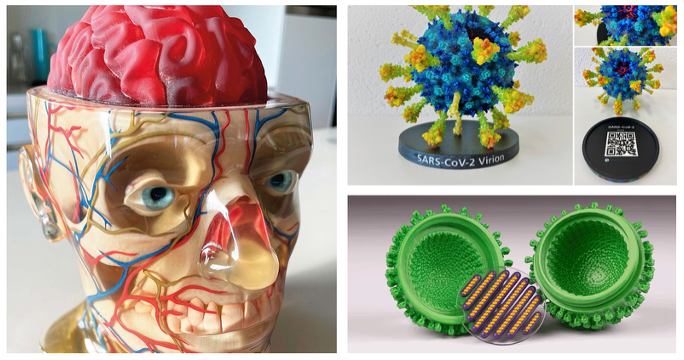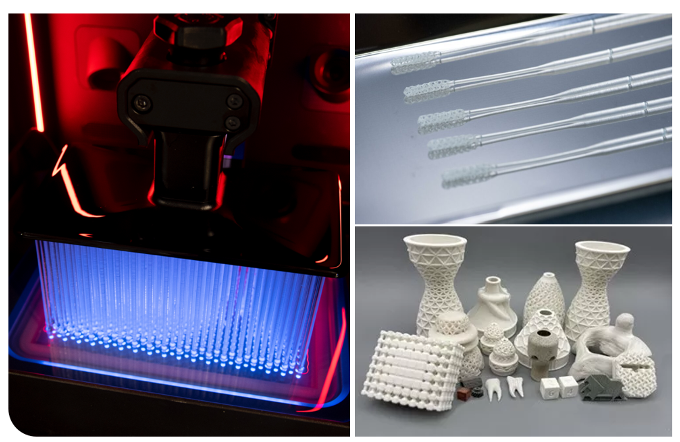Date: November 10, 2025
Time: 10 a.m. – 3:15 p.m.
Location: MIT.nano, 12-0168
Join MIT.nano for a series of 3D printing tool talks highlighting the rapidly evolving landscape of additive manufacturing of photopolymers and showcasing the diverse 3D printing capabilities available in the MIT.nano prototyping facilities. The event includes tool talks from the makers of Mimaki and Stratasys 3D printers, Q&A sessions, and a guided tour of MIT.nano/APT’s Digital Polymer Manufacturing Facility (DPMF) 3D printing space.
Registration is free and open to the MIT community and the general public. Coffee and lunch will be provided.

Photorealistic full-color models for education and visualization.

Examples of printed medical instruments, diagnostic devices, ceramic & metal parts.
Agenda
Monday, November 10
10:00 – 10:30 AM | Welcome & facility overview over coffee & snacks Overview of the DPMF’s 3D printing and prototyping capabilities. Participants will learn about the facility, access procedures, available equipment, and how to engage the equipment for use. Additionally, participants will be invited for feedback on machine tool capabilities that they would like to see added in the future. |
10:30 – 12:30 PM | Tool talk 1: Mimaki 3DUJ-2207: Full-color 3D printing Nick Gondek (Director of Additive, ADIA); Matthew Stark (3D Segment Manager, Mimaki USA), Eammon Littler (QUEL Imaging) |
12:30 – 2:00 PM | Tool talk 2: Stratasys Origin One: Flexible materials development platform for photopolymer chemistries Christopher Wier (Applications Engineer, Stratasys) |
2:00 – 2:45 PM | Lunch, open discussion, networking & closing remarks |
2:45 – 3:15 PM | Lab tour – Guided walk through the DPMF 3D printing and prototyping space |
Abstracts & Speaker Bios
Tool talk 1: Mimaki 3DUJ-2207: Full-color 3D printing
Matthew Stark (Mimaki USA), Nick Gondek (Adia, Inc.), and Eammon Littler (QUEL Imaging) will explore how full-color 3D printing is transforming industries around the world. Mimaki users are pushing the boundaries of additive manufacturing in research and development, product design, engineering, and the arts through highly detailed models, functional prototypes, and visually compelling products across a wide range of applications.
The talk will also provide a technical overview of Mimaki’s material jetting technology, highlighting what differentiates it from other color 3D printing systems in terms of precision, color accuracy, and workflow efficiency. The talk will also spotlight applications in the printing of tissue-equivalent optical phantoms for medical imaging device calibration. Attendees will have the opportunity to examine physical printed models and follow along as the presenters walk through the complete workflow, from design to finished part, on Mimaki’s full-color 3D printers.
Biographies
Matthew Stark is the 3D segment manager at Mimaki USA, where he leads efforts to expand Mimaki’s full-color 3D printing technology into new markets, focusing on full-scale production, education, medical modeling, and manufacturing. Since transferring from Mimaki Engineering in Japan to the U.S. in 2023, he has focused on building a stronger 3D sales channel and promoting cost-effective, color-accurate workflows that bridge creativity and production. Before joining Mimaki USA, he worked in global marketing for Mimaki Engineering’s 3D printing division, contributing to the worldwide promotion of the company’s cutting-edge full-color 3D printing systems. His earlier experience includes business development and cross-cultural management in Japan’s engineering and education sectors. He holds a graduate degree in Economics from Nagoya University, where he was a MEXT scholar, and an undergraduate degree in International Business from the University of Denver.
Nick Gondek is one of the principals and a founder of Adia Inc., an engineering firm that designs, implements, and supports full-process solutions centered on additive manufacturing. With a background in Engineering Physics, he works with OEMs and research institutions to deploy these technologies within industry, enabling high-value applications and extending the capability of AM systems. His team’s work spans software development, hardware integration, and field engineering—ensuring complete, reliable processes from concept through implementation. Nick also leads the Another Day in Additive Users Group, a New England community connecting engineers and innovators.
Eammon Littler is a software engineer at QUEL Imaging, where he focuses on research in voxel-based 3D printing and computer vision, develops CAD designs, and creates hardware tools for product testing and validation. He received his BS degree from Wheaton College in Massachusetts and his MS degree in computer science from Dartmouth College. He serves as an adjunct professor in the computer science department at Dartmouth College, where he teaches digital arts. His research interests include algorithmic and generative design, and he is an avid hobbyist in 3D printing.
Tool talk 2: Stratasys Origin One: Flexible materials development platform for photopolymer chemistries
Chris Wier will introduce the Stratasys Origin One system, an advanced additive manufacturing platform based on Digital Light Processing (DLP) technology. The talk will cover the system architecture, including the light engine, resin tray, and optics, and discuss accuracy, surface quality, and key maintenance and safety considerations.
Attendees will gain insight into the design-to-print workflow, from CAD modeling and slicing to resin preparation, printing, and post-processing. The presentation will also highlight the GrabCAD Print (Origin) software environment, with discussion of build orientation, support strategies, and parameter tuning for exposure, cure depth, and layer height optimization.
Finally, the talk will review the range of available resin families, including engineering, elastomeric, biocompatible, high-temperature, and specialty materials, and showcase representative applications relevant to research and prototyping. Guidance will be provided on selecting the appropriate resin for specific project needs.
Biography
Chris Wier is an applications engineer at Stratasys, supporting all five core additive manufacturing platforms—Fused Deposition Modeling (FDM), PolyJet, Digital Light Projection (DLP), Stereolithography (SLA), and Selective Absorption Fusion (SAF). With more than a decade of experience in industrial additive manufacturing, he specializes in process development, materials optimization, and advanced applications training. In his role, Chris collaborates with customers and cross-functional teams to evaluate design requirements, identify suitable technologies, and implement additive workflows that meet production, prototyping, and tooling objectives.
Exhibit & Demonstrations
Printed sample displays will highlight the strengths of the featured systems: full-color prints and high-precision resin components from the Mimaki and Stratasys systems. A digital microscope station will provide live views of microscale prints.
Contact
For questions or presentation proposals, please contact:
Elijah Shirman, PhD (MIT.nano)
Haden Quinlan (MIT APT and INM)
